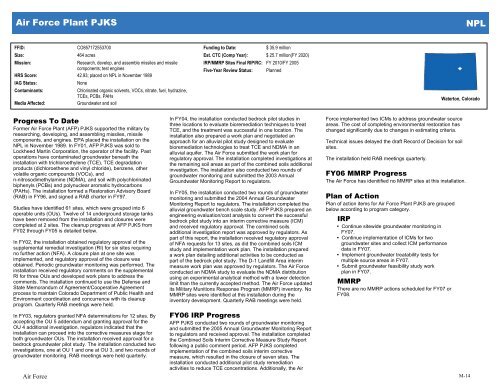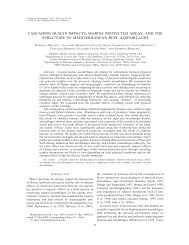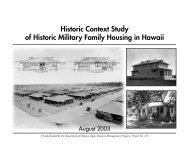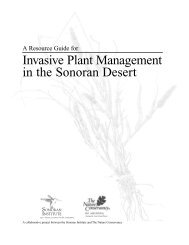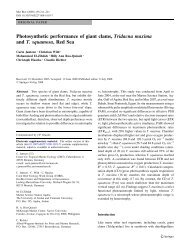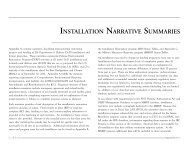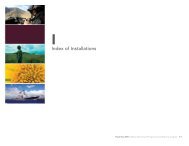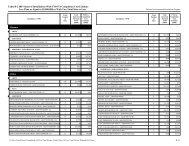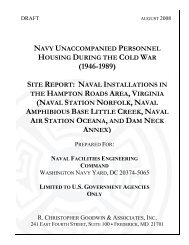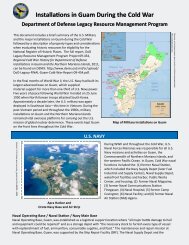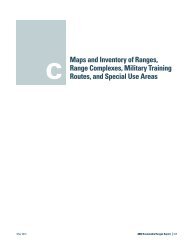Appendix M: Installation Narrative Summaries - denix
Appendix M: Installation Narrative Summaries - denix
Appendix M: Installation Narrative Summaries - denix
Create successful ePaper yourself
Turn your PDF publications into a flip-book with our unique Google optimized e-Paper software.
e��2p���2€�—��2€tuƒ x€v<br />
2ppshX<br />
2ƒ���X<br />
2w������X<br />
2r‚ƒ2ƒ���X<br />
2seq2ƒ�—���X<br />
2g���—���—���X<br />
2w���—2e������X<br />
€�������2„�2h—��<br />
Former Air Force Plant (AFP) PJKS supported the military by<br />
researching, developing, and assembling missiles, missile<br />
components, and engines. EPA placed the installation on the<br />
NPL in November 1989. In FY01, AFP PJKS was sold to<br />
Lockheed Martin Corporation, the operator of the facility. Past<br />
operations have contaminated groundwater beneath the<br />
installation with trichloroethylene (TCE), TCE degradation<br />
products (dichloroethene and vinyl chloride), benzene, other<br />
volatile organic compounds (VOCs), and<br />
n-nitrosodimethylamine (NDMA), and soil with polychlorinated<br />
biphenyls (PCBs) and polynuclear aromatic hydrocarbons<br />
(PAHs). The installation formed a Restoration Advisory Board<br />
(RAB) in FY96, and signed a RAB charter in FY97.<br />
Studies have identified 61 sites, which were grouped into 6<br />
operable units (OUs). Twelve of 14 underground storage tanks<br />
have been removed from the installation and closures were<br />
completed at 2 sites. The cleanup progress at AFP PJKS from<br />
FY02 through FY05 is detailed below.<br />
In FY02, the installation obtained regulatory approval of the<br />
supplemental remedial investigation (RI) for six sites requiring<br />
no further action (NFA). A closure plan at one site was<br />
implemented, and regulatory approval of the closure was<br />
obtained. Periodic groundwater monitoring was performed. The<br />
installation received regulatory comments on the supplemental<br />
RI for three OUs and developed work plans to address the<br />
comments. The installation continued to use the Defense and<br />
State Memorandum of Agreement/Cooperative Agreement<br />
process to maintain Colorado Department of Public Health and<br />
Environment coordination and concurrence with its cleanup<br />
program. Quarterly RAB meetings were held.<br />
In FY03, regulators granted NFA determinations for 12 sites. By<br />
accepting the OU 5 addendum and granting approval for the<br />
OU 4 additional investigation, regulators indicated that the<br />
installation can proceed into the corrective measures stage for<br />
both groundwater OUs. The installation received approval for a<br />
bedrock groundwater pilot study. The installation conducted two<br />
investigations, one at OU 1 and one at OU 3, and two rounds of<br />
groundwater monitoring. RAB meetings were held quarterly.<br />
Air Force<br />
gyVSUIUPSSQUHH<br />
RTR2—���<br />
‚���—��D2�������D2—��2—����˜��2��������2—��2�������2<br />
���������Y2����2�������<br />
RPFWQY2��—��2��2x€v2��2x����˜��2IWVW<br />
x���<br />
g������—���2���—��2��������D2†yg�D2����—��D2����D2����—����D2<br />
„gi�D2€gf�D2€er�<br />
q������—���2—��2����<br />
2p������2��2h—��X<br />
62QSFW2�������<br />
2i��F2g„g2@g���2‰�—�AX 62PSFU2�������@p‰2PHPHA<br />
2s‚€Gww‚€2ƒ����2p��—�2‚s€G‚gX p‰2PHIHGp‰2PHHS<br />
2p���E‰�—�2‚�����2ƒ�—���X €�—����<br />
In FY04, the installation conducted bedrock pilot studies in<br />
three locations to evaluate bioremediation techniques to treat<br />
TCE, and the treatment was successful in one location. The<br />
installation also prepared a work plan and negotiated an<br />
approach for an alluvial pilot study designed to evaluate<br />
bioremediation technologies to treat TCE and NDMA in an<br />
alluvial aquifer. The Air Force submitted the work plan for<br />
regulatory approval. The installation completed investigations at<br />
the remaining soil areas as part of the combined soils additional<br />
investigation. The installation also conducted two rounds of<br />
groundwater monitoring and submitted the 2003 Annual<br />
Groundwater Monitoring Report to regulators.<br />
In FY05, the installation conducted two rounds of groundwater<br />
monitoring and submitted the 2004 Annual Groundwater<br />
Monitoring Report to regulators. The installation completed the<br />
alluvial groundwater bench scale study. AFP PJKS prepared an<br />
engineering evaluation/cost analysis to convert the successful<br />
bedrock pilot study into an interim corrective measure (ICM)<br />
and received regulatory approval. The combined soils<br />
additional investigation report was approved by regulators. As<br />
part of this report, the installation received regulatory approval<br />
of NFA requests for 13 sites, as did the combined soils ICM<br />
study and implementation work plan. The installation prepared<br />
a work plan detailing additional activities to be conducted as<br />
part of the bedrock pilot study. The D-1 Landfill Area interim<br />
measure work plan was approved by regulators. The Air Force<br />
conducted an NDMA study to evaluate the NDMA distribution<br />
using an experimental analytical method with a lower detection<br />
limit than the currently accepted method. The Air Force updated<br />
its Military Munitions Response Program (MMRP) inventory. No<br />
MMRP sites were identified at this installation during the<br />
inventory development. Quarterly RAB meetings were held.<br />
p‰HT2s‚€2€�������<br />
AFP PJKS conducted two rounds of groundwater monitoring<br />
and submitted the 2005 Annual Groundwater Monitoring Report<br />
to regulators and received approval. The installation completed<br />
the Combined Soils Interim Corrective Measure Study Report<br />
following a public comment period. AFP PJKS completed<br />
implementation of the combined soils interim corrective<br />
measure, which resulted in the closure of seven sites. The<br />
installation conducted additional pilot study remediation<br />
activities to reduce TCE concentrations. Additionally, the Air<br />
Force implemented two ICMs to address groundwater source<br />
areas. The cost of completing environmental restoration has<br />
changed significantly due to changes in estimating criteria.<br />
Technical issues delayed the draft Record of Decision for soil<br />
sites.<br />
The installation held RAB meetings quarterly.<br />
p‰HT2ww‚€2€�������<br />
The Air Force has idenitified no MMRP sites at this installation.<br />
€�—�2��2e����<br />
Plan of action items for Air Force Plant PJKS are grouped<br />
below according to program category.<br />
22222s‚€<br />
0 Continue sitewide groundwater monitoring in<br />
FY07.<br />
0 Continue implementation of ICMs for two<br />
groundwater sites and collect ICM performance<br />
data in FY07.<br />
0 Implement groundwater treatability tests for<br />
multiple source areas in FY07.<br />
0 Submit groundwater feasibility study work<br />
plan in FY07.<br />
22222ww‚€<br />
There are no MMRP actions scheduled for FY07 or<br />
FY08.<br />
‡—������D2g����—��<br />
M-14


